Synthesis Methods of Obtaining Materials for Hydrogen Sensors
Abstract
:1. Introduction
2. Synthesis Methods
2.1. Sol-Gel
2.2. Co-Precipitation
2.3. Spin Coating
2.4. Pulsed Laser Deposition (PLD)
3. Conclusions
Author Contributions
Funding
Institutional Review Board Statement
Informed Consent Statement
Data Availability Statement
Acknowledgments
Conflicts of Interest
References
- Noh, H.J.; Kim, H.-J.; Park, Y.M.; Park, J.-S.; Lee, H.-N. Complex behavior of hydrogen sensor using nanoporous palladium film prepared by evaporation. Appl. Surf. Sci. 2019, 480, 52–56. [Google Scholar] [CrossRef]
- Jaballah, S.; Dahman, H.; Ghiloufi, I.; Neri, G.; El Mir, L. Facile synthesis of Al-Mg co-doped ZnO nanoparticles and their high hydrogen sensing performances. Int. J. Hydrogen Energy 2020, 45, 34268–34280. [Google Scholar] [CrossRef]
- Nguyen, T.D.T.; Van Dao, D.; Kim, D.-S.; Lee, H.-J.; Oh, S.-Y.; Lee, I.-H.; Yu, Y.-T. Effect of core and surface area toward hydrogen gas sensing performance using Pd@ZnO core-shell nanoparticles. J. Colloid Interface Sci. 2021, 587, 252–259. [Google Scholar] [CrossRef]
- Chen, K.; Yuan, D.; Zhao, Y. Review of optical hydrogen sensors based on metal hydrides: Recent developments and challenges. Opt. Laser Technol. 2021, 137, 106808. [Google Scholar] [CrossRef]
- Xu, H.; Liu, Y.; Liu, H.; Dong, S.; Wu, Y.; Wang, Z.; Wang, Y.; Wu, M.; Han, Z.; Hao, L. Pd-decorated 2D SnSe ultrathin film on SiO2/Si for room-temperature hydrogen detection with ultrahigh response. J. Alloys Compd. 2021, 851, 156844. [Google Scholar] [CrossRef]
- Yue, M.; Lambert, H.; Pahon, E.; Roche, R.; Jemei, S.; Hissel, D. Hydrogen energy systems: A critical review of technologies, applications, trends and challenges. Renew. Sustain. Energy Rev. 2021, 146, 111180. [Google Scholar] [CrossRef]
- Yang, T.; Zhangn, Y.; Li, C. Large scale production of spherical WO3 powder with ultrasonic spray pyrolysis assisted by sol–gel method for hydrogen detection. Ceram. Int. 2014, 40, 1765–1769. [Google Scholar] [CrossRef]
- Mirzaei, A.; Yousefi, H.R.; Falsafi, F.; Bonyani, M.; Lee, J.-H.; Kim, J.-H.; Kim, H.W.; Kim, S.S. An overview on how Pd on resistive-based nanomaterial gas sensors can enhance response toward hydrogen gas. Int. J. Hydrogen Energy 2019, 44, 20552–20571. [Google Scholar] [CrossRef]
- Del Orbe Henriquez, D.; Cho, I.; Yang, H.; Choi, J.; Kang, M.; Chang, K.S.; Jeong Bae, C.; Han, S.W.; Park, I. Pt Nanostructures Fabricated By Local Hydrothermal Synthesis For Low-Power Catalytic-Combustion Hydrogen Sensors. ACS Appl. Nano Mater. 2021, 4, 7–12. [Google Scholar] [CrossRef]
- Liu, W.; Zuo, H.; Wang, J.; Xue, Q.; Ren, B.; Yang, F. The production and application of hydrogen in steel industry. Int. J. Hydrogen Energy 2021, 46, 10548–10569. [Google Scholar]
- Okolie, J.A.; Patra, B.R.; Mukherjee, A.; Nanda, S.; Dalai, A.K.; Kozinski, J.A. Futuristic applications of hydrogen in energy, biorefining, aerospace, pharmaceuticals and metallurgy. Int. J. Hydrogen Energy 2021, 46, 8885–8905. [Google Scholar] [CrossRef]
- Li, X.; Gao, Z.; Li, B.; Zhang, X.; Li, Y.; Sun, J. Self-healing superhydrophobic conductive coatings for self-cleaning and humidity-insensitive hydrogen sensors. Chem. Eng. J. 2021, 410, 128353. [Google Scholar] [CrossRef]
- Zhang, Y.; Peng, H.; Zhou, T.; Zhang, L.; Zhang, Y.; Zhao, Y. Hydrogen sensor based on high-birefringence fiber loop mirror with sol-gel Pd/WO3 coating. Sens. Actuator B-Chem. 2017, 248, 71–76. [Google Scholar] [CrossRef] [Green Version]
- Han, Z.; Ren, J.; Zhou, J.; Zhang, S.; Zhang, Z.; Yang, L.; Yin, C. Multilayer porous Pd-WO3 composite thin films prepared by sol-gel process for hydrogen sensing. Int. J. Hydrogen Energy 2020, 45, 7223–7233. [Google Scholar] [CrossRef]
- Hashtroudi, H.; Kumar, R.; Savu, R.; Moshkalev, S.; Kawamura, G.; Matsuda, A.; Shafiei, M. Hydrogen gas sensing properties of microwaveassisted 2D Hybrid Pd/rGO: Effect of temperature, humidity and UV illumination. Int. J. Hydrogen Energy 2021, 46, 7653–7665. [Google Scholar] [CrossRef]
- Huang, L.; Applegate, R.L.; Applegate, P.M.; Gong, L.; Ocak, U.; Boling, W.; Zhang, J.H. Inhalation of high-concentration hydrogen gas attenuates cognitive deficits in a rat model of asphyxia, induced-cardiac arrest. Med. Gas Res. 2019, 9, 122–126. [Google Scholar] [CrossRef] [PubMed]
- Li, Z.; Yao, Z.J.; Haidry, A.A.; Plecenik, T.; Xie, L.J.; Sun, L.C.; Fatima, Q. Resistive-type hydrogen gas sensor based on TiO2: A review. Int. J. Hydrogen Energy 2018, 43, 21114–21132. [Google Scholar] [CrossRef]
- Kheel, H.; Sun, G.-J.; Lee, J.K.; Mirzaei, A.; Choi, S.; Lee, C. Hydrogen Gas Detection of Nb2O5 Nanoparticle-Decorated CuO Nanorod Sensors. Met. Mater. Int. 2017, 23, 214–219. [Google Scholar] [CrossRef]
- Jiang, M.; Xu, K.; Liao, N.; Zhou, H. First principles investigation on selective hydrogen sensing properties of a-phase TeO2. Int. J. Hydrogen Energy. 2021, 46, 4666–4672. [Google Scholar] [CrossRef]
- Yadav, A.B.; Jit, S. Particle size effects on the hydrogen sensing properties of Pd/ZnO Schottky contacts fabricated by sol-gel method. Int. J. Hydrogen Energy 2017, 42, 786–794. [Google Scholar] [CrossRef]
- Mouli-Castillo, J.; Orr, G.; Thomas, J.; Hardy, N.; Crowther, M.; Stuart Haszeldine, R.; Wheeldon, M.; McIntosh, A. A comparative study of odorants for gas escape detection of natural gas and hydrogen. Int. J. Hydrogen Energy 2021, 46, 14881–14893. [Google Scholar] [CrossRef]
- Hübert, T.; Boon-Brett, L.; Black, G.; Banach, U. Hydrogen sensors—A review. Sens. Actuator B-Chem. 2011, 157, 329–352. [Google Scholar] [CrossRef]
- Wang, W.; Liu, X.; Mei, S.; Jia, Y.; Liu, M.; Xue, X.; Yang, D. Development of a Pd/Cu nanowires coated SAW hydrogen gas sensor with fast response and recovery. Sens. Actuator B-Chem. 2019, 287, 157–164. [Google Scholar] [CrossRef]
- Miu, D.; Birjega, R.; Viespe, C. Surface Acoustic Wave Hydrogen Sensors Based on Nanostructured Pd/WO3 Bilayers. Sensors 2018, 18, 3636. [Google Scholar] [CrossRef] [PubMed] [Green Version]
- Harathi, N.; Kavitha, S.; Sarkar, A. ZnO nanostructured 2D layered SAW based hydrogen gas sensor with enhanced sensitivity. Mater. Today Proc. 2020, 33, 2621–2625. [Google Scholar] [CrossRef]
- Al-Asedy, H.J.; Bidin, N.; Al-khafaji, S.A.; Bakhtiar, H. Sol-gel grown aluminum/gallium co-doped ZnO nanostructures: Hydrogen gas sensing attributes. Mater. Sci. Semicond. Process 2018, 77, 50–57. [Google Scholar] [CrossRef]
- Iordache, S.M.; Ionete, E.I.; Iordache, A.M.; Tanasa, E.; Stamatin, I.; Grigorescu, C.E.A. Pd-decorated CNT as sensitive material for applications in hydrogen isotopes sensing—Application as gas sensor. Int. J. Hydrogen Energy 2021, 46, 11. [Google Scholar] [CrossRef]
- Nguyen, T.D.T.; Van Dao, D.; Lee, I.H.; Yu, Y.T.; Oh, S.Y. High response and selectivity toward hydrogen gas detection by In2O3 doped Pd@ZnO core-shell nanoparticles. J. Alloy. Compd 2021, 854, 157280. [Google Scholar] [CrossRef]
- Kim, J.-H.; Mirzaei, A.; Kim, H.W.; Kim, S.S. Improving the hydrogen sensing properties of SnO2 nanowire-based conductometric sensors by Pd-decoration. Sens. Actuator B-Chem. 2019, 285, 358–367. [Google Scholar] [CrossRef]
- Jamnani, S.R.; Moghaddam, H.M.; Leonardi, S.G.; Neri, G. PANI/Sm2O3 nanocomposite sensor for fast hydrogen detection at room temperature. Synth. Met. 2020, 268, 116493. [Google Scholar] [CrossRef]
- Kaewsiri, D.; Inyawilert, K.; Wisitsoraat, A.; Tuantranont, A.; Phanichphantc, S.; Liewhiran, C. Flame-spray-made PtOx-functionalized Zn2SnO4 spinel nanostructures for conductometric H2 detection. Sens. Actuator B-Chem. 2020, 316, 128132. [Google Scholar] [CrossRef]
- Çoban, Ö.; Gür, E.; Tüzemen, S. Platinum activated WO3 optical hydrogen sensors. Mater. Today Proc. 2021, 46, 6913–6915. [Google Scholar] [CrossRef]
- Yue, Y.; Ding, H.; Chen, C. Optical hydrogen sensors based on silica self-assembledmesoporous microspheres. Int. J. Hydrogen Energy 2021, 46, 1403–1410. [Google Scholar] [CrossRef]
- Mustaffa, S.N.A.; Ariffin, N.A.; Khalaf, A.L.; Yaacob, M.H.; Tamchek, N.; Paiman, S.; Sagadevan, S. Sensing mechanism of an optimized room temperature optical hydrogen gas sensor made of zinc oxide thin films. J. Mater. Res. Technol. 2020, 9, 10624–10634. [Google Scholar] [CrossRef]
- Sturm, H.; Brauns, E.; Seemann, T.; Zoellmer, V.; Lang, W. A highly sensitive catalytic gas sensor for hydrogen detection based on sputtered nanoporous platinum. Procedia Eng. 2010, 5, 123–126. [Google Scholar] [CrossRef]
- Jang, W.; Park, J.-S.; Lee, K.-W.; Roh, Y. Methane and hydrogen sensing properties of catalytic combustion type single-chip micro gas sensors with two different Pt film thicknesses for heaters. Micro Nano Syst. Lett. 2018, 6, 7. [Google Scholar] [CrossRef]
- Brauns, E.; Morsbach, E.; Bäumer, M.; Lang, W. A fast and sensitive catalytic hydrogen sensor based on a stabilized nanoparticle catalyst. In Proceedings of the 2013 Transducers & Eurosensors XXVII: The 17th International Conference on Solid-State Sensors, Actuators and Microsystems (TRANSDUCERS & EUROSENSORS XXVII), Barcelon, Spain, 16–20 June 2013. [Google Scholar]
- Fedorenko, G.; Oleksenko, L.; Maksymovych, N. Oxide Nanomaterials Based on SnO2 for Semiconductor Hydrogen Sensors. Adv. Mater. Sci. Eng. 2019, 2019, 5190235. [Google Scholar] [CrossRef] [Green Version]
- Foo Choo, T.; Ubaidah Saidin, N.; Ying Kok, K. Hydrogen sensing enhancement of zinc oxide nanorods via voltage biasing. R. Soc. Open Sci. 2018, 5, 172372. [Google Scholar] [CrossRef] [Green Version]
- Del Orbe, D.V.; Yang, H.; Cho, I.; Park, J.; Choi, J.; Han, S.W.; Park, I. Low-power thermocatalytic hydrogen sensor based on electrodeposited cauliflower-like nanostructured Pt black. Sens. Actuators B. Chem. 2021, 329, 129129. [Google Scholar] [CrossRef]
- Tian, J.; Jiang, H.; Zhao, X.; Shi, G.; Zhang, J.; Deng, X.; Zhang, W. A Ppb-level hydrogen sensor based on activated Pd nanoparticles loaded on oxidized nickel foam. Sens. Actuators B. Chem. 2021, 329, 129194. [Google Scholar] [CrossRef]
- Yang, Z.; Du, X.; Ye, X.; Qu, X.; Duan, H.; Xing, Y.; Shao, L.-H.; Chen, C. The free-standing nanoporous palladium for hydrogen isotope storage. J. Alloy. Compd. 2021, 854, 157062. [Google Scholar] [CrossRef]
- Nugroho, F.A.A.; Darmadi, I.; Cusinato, L.; Susarrey-Arce, A.; Schreuders, H.; Bannenberg, L.J.; Bastos da Silva Fanta, A.; Kadkhodazadeh, S.; Wagner, J.B.; Antosiewicz, T.J.; et al. Metal–polymer hybrid nanomaterials for plasmonic ultrafast hydrogen detection. Nat. Mater. 2019, 18, 489–495. [Google Scholar] [CrossRef] [Green Version]
- Östergren, I.; Pourrahimi, A.M.; Darmadi, I.; da Silva, R.; Stolaś, A.; Lerch, S.; Berke, B.; Guizar-Sicairos, M.; Liebi, M.; Foli, G.; et al. Highly Permeable Fluorinated Polymer Nanocomposites for Plasmonic Hydrogen Sensing. ACS Appl. Mater. Interfaces 2021, 13, 21724–21732. [Google Scholar] [CrossRef]
- Ye, Z.; Li, Z.; Dai, J.; Qin, Y.; Wang, G.; Yuan, Z.; Yang, M. Hydrogen sensing performance investigations with optical heating and sensing element surface modification. Int. J. Hydrogen Energy 2021, 46, 1411–1419. [Google Scholar] [CrossRef]
- Das, S.; Roy, S.; Bhattacharya, T.S.; Sarkar, C.K. Efficient Room Temperature Hydrogen Gas Sensor Using ZnO Nanoparticles-Reduced Graphene Oxide Nanohybrid. IEEE Sens. J. 2021, 21, 2. [Google Scholar] [CrossRef]
- Seo, M.-H.; Kang, K.; Yoo, J.-Y.; Park, J.; Lee, J.-S.; Cho, I.; Kim, B.-J.; Jeong, Y.; Lee, J.-Y.; Kim, B.; et al. Chemo-Mechanically Operating Palladium- Polymer Nanograting Film for a Self-Powered H2 Gas Sensor. ACS Nano 2020, 14, 16813–16822. [Google Scholar] [CrossRef] [PubMed]
- Hazra, A.; Das, S.; Kanungo, J.; Sarkar, C.K.; Basu, S. Studies on a resistive gas sensor based on sol–gel grown nanocrystalline p-TiO2 thin film for fast hydrogen detection. Sens. Actuator B-Chem. 2013, 183, 7–95. [Google Scholar] [CrossRef]
- Sarala Devi, G.; Siva Prasada Reddy, P.; Ramya, K. Sol-Gel Derived Zno: Nb2O5 Nanocomposite As Selective Hydrogen (H2) Gas Sensor. Mater. Today Proc. 2016, 3, 224–229. [Google Scholar] [CrossRef]
- Ling, C.; Xue, Q.; Han, Z.; Lu, H.; Xia, F.; Yan, Z.; Deng, L. Room temperature hydrogen sensor with ultrahigh-responsive characteristics based on Pd/SnO2/SiO2/Si heterojunctions. Sens. Actuator B-Chem. 2016, 227, 438–447. [Google Scholar] [CrossRef]
- Moon, J.; Hedman, H.P.; Kemell, M.; Tuominen, A.; Punkkinen, R. Hydrogen sensor of Pd-decorated tubular TiO2 layer prepared by anodization with patterned electrodes on SiO2/Si substrate. Sens. Actuator B-Chem. 2016, 222, 190–197. [Google Scholar] [CrossRef]
- Kabcum, S.; Channei, D.; Tuantranont, A.; Wisitsoraat, A.; Liewhiran, C.; Phanichphant, S. Ultra-responsive hydrogen gas sensors based on PdO nanoparticle-decorated WO3 nanorods synthesized by precipitation and impregnation methods. Sens. Actuator B-Chem. 2016, 226, 76–89. [Google Scholar] [CrossRef]
- Kim, J.-H.; Mirzaei, A.; Kim, H.W.; Kim, S.S. Combination of Pd loading and electron beam irradiation for superior hydrogen sensing of electrospun ZnO nanofibers. Sens. Actuator B-Chem. 2019, 284, 628–637. [Google Scholar] [CrossRef]
- Gautam, Y.K.; Kumar, A.; Ambedkar, A.K.; Kumar, V.; Pal Singh, B. Hydrogen induced resistance and optical transmittance of pulsed laser deposited Pd/Mg thin films. Appl. Innov. Res. 2019, 1, 96–100. [Google Scholar]
- Tonezzer, M.; Iannotta, S. H2 sensing properties of two-dimensional zinc oxide nanostructures. Talanta 2014, 122, 201–208. [Google Scholar] [CrossRef] [PubMed]
- Su, P.-G.; Liao, S.-L. Fabrication of a flexible H2 sensor based on Pd nanoparticles modified polypyrrole films. Mater. Chem. Phys. 2016, 170, 180–185. [Google Scholar] [CrossRef]
- Kumar Singh, P.; Kumar, P.; Kumar Das, A. Unconventional Physical Methods for Synthesis of Metal and Non-metal Nanoparticles: A Review. Proc. Natl. Acad. Sci. India Sect. A Phys. Sci. 2019, 89, 199–221. [Google Scholar] [CrossRef]
- Ge, Y.; Shi, Z.; Tan, C.; Chen, Y.; Cheng, H.; He, Q.; Zhang, H. Two-Dimensional Nanomaterials with Unconventional Phases. Chem 2020, 6, 1237–1253. [Google Scholar] [CrossRef]
- Kadhim, I.H.; Hassan, H.A.; Ibrahim, F.T. Hydrogen gas sensing based on nanocrystalline SnO2 thin films operating at low temperatures. Int. J. Hydrogen Energy 2020, 45, 25599–25607. [Google Scholar] [CrossRef]
- Chen, Y.; Fan, Z.; Zhang, Z.; Niu, W.; Li, C.; Yang, N.; Chen, B.; Zhang, H. Two-Dimensional Metal Nanomaterials: Synthesis, Properties, and Applications. Chem. Rev. 2018, 118, 6409–6455. [Google Scholar] [CrossRef] [PubMed]
- Zhang, C.; Yao, Y.; Wang, J.; Huang, H.; Wang, H. The Hydrogen Sensors Based on the Dandelion-like Nanostructured TiO2. In Proceedings of the 2019 IEEE International Conference on Manipulation, Manufacturing and Measurement on the Nanoscale (3M-NANO), Zhejiang, China, 4–8 August 2019. [Google Scholar]
- Nikolaeva, N.S.; Klyamer, D.D.; Zharkov, S.M.; Tsygankova, A.R.; Sukhikh, A.S.; Morozova, N.B.; Basova, T.V. Heterostructures based on PdeAu nanoparticles and cobalt phthalocyanine for hydrogen chemiresistive sensors. Int. J. Hydrogen Energy 2021, 46, 19682–19692. [Google Scholar] [CrossRef]
- Jeong, G.; Kim, S.; Nam, B.; Lee, C. Synthesis of nanograined ZnO nanorods functionalized with NiO nanoparticles and their enhanced hydrogen sensing properties. J. Korean Phys. Soc. 2021, 78, 259–268. [Google Scholar] [CrossRef]
- Viespe, C. Surface Acoustic Wave Sensors Based on Nanoporous Films for Hydrogen Detection; Key Engineering Materials; Trans Tech Publications, Ltd: Stafa-Zurich, Switzerland, 2014; Volume 605, pp. 331–334. [Google Scholar]
- Marcu, A.; Viespe, C. Surface AcousticWave Sensors for Hydrogen and Deuterium Detection. Sensors 2017, 17, 1417. [Google Scholar] [CrossRef] [PubMed] [Green Version]
- Maksimova, N.K.; Sevastyanov, E.Y.; Chernikov, E.V.; Korusenko, P.M.; Nesov, S.N.; Kim, S.V.; Biryukov, A.A.; Sergeychenko, N.V.; Davletkildeev, N.A.; Sokolov, D.V. Sensors based on tin dioxide thin films for the detection of pre-explosive hydrogen concentrations. Sens. Actuators: B. Chem. 2021, 341, 130020. [Google Scholar] [CrossRef]
- Rahaman, H.; Yaqoob, U.; Uddin, M.; Kim, H.C. Highly catalytic hydrogen sensing properties of the nano percolated Pd/Mg/Ti nanoparticles layers decorated on Si substrate. Appl. Surf. Sci. 2021, 549, 149203. [Google Scholar] [CrossRef]
- Fomekong, R.L.; Kelm, K.; Saruhan, B. High-Temperature Hydrogen Sensing Performance of Ni-Doped TiO2 Prepared by Co-Precipitation Method. Sensors 2020, 20, 5992. [Google Scholar] [CrossRef]
- Pathania, A.; Thakur, P.; Trukhanov, A.V.; Trukhanov, S.V.; Panina, L.V.; Lüders, U.; Thakur, A. Development of tungsten doped Ni-Zn nano-ferrites with fast response and recovery time for hydrogen gas sensing application. Results Phys. 2019, 15, 102531. [Google Scholar] [CrossRef]
- Abdullah, Q.N.; Ahmed, A.R.; Ali, A.M.; Yam, F.K.; Hassan, Z.; Bououdina, M. Novel SnO2-coated b-Ga2O3 nanostructures for room temperature hydrogen gas sensor. Int. J. Hydrogen Energy 2021, 46, 7000–7010. [Google Scholar] [CrossRef]
- Choi, J.-H.; Park, T.; Hur, J.; Cha, H.-Y. Room Temperature Operation of UV Photocatalytic Functionalized AlGaN/GaN Heterostructure Hydrogen Sensor. Nanomaterials 2021, 11, 1422. [Google Scholar] [CrossRef]
- Dai, J.; Li, Y.; Ruan, H.; Ye, Z.; Chai, N.; Wang, X.; Qiu, S.; Bai, W.; Yang, M. Fiber Optical Hydrogen Sensor Based on WO3-Pd2Pt-Pt Nanocomposite Films. Nanomaterials 2021, 11, 128. [Google Scholar] [CrossRef]
- Suzuki, A.; Yukawa, H. A Review for Consistent Analysis of Hydrogen Permeability through Dense Metallic Membranes. Membranes 2020, 10, 120. [Google Scholar] [CrossRef]
- Hien, H.T.; Giang, H.T.; Van Hieu, N.; Trung, T.; Van Tuan, C. Elaboration of Pd-nanoparticle decorated polyaniline films for room temperature NH3gas sensors. Sens. Actuator B-Chem. 2017, 249, 348–356. [Google Scholar] [CrossRef]
- Yin, X.T.; Li, J.; Dastan, D.; Zhou, W.D.; Garmestani, H.; Alamgir, F.M. Ultra-high selectivity of H2 over CO with a p-n nanojunction based gas sensors and its mechanism. Sens. Actuator B-Chem. 2020, 319, 128330. [Google Scholar] [CrossRef]
- Kumari, R.; Kumar, V. Synthesis and characterization of Tin-(0.00, 0.02, 0.04, 0.06 and 0.08) doped Cadmium oxide films grown by unconventional sol—Gel screen-printing procedure. Opt. Int. J. Light Electron Opt. 2020, 219, 165266. [Google Scholar] [CrossRef]
- Danks, A.E.; Hall, S.R.; Schnepp, Z. The evolution of ‘sol–gel’ chemistry as a technique for materials synthesis. Mater. Horiz. 2016, 3, 91. [Google Scholar] [CrossRef] [Green Version]
- Ye, C.Q. Sol-Gel Processes of Functional Powders and Films, Chemical Reactions in Inorganic Chemistry, Saravanan Chandraleka, IntechOpen. 20 December 2017. Available online: https://www.intechopen.com/books/chemical-reactions-in-inorganic-chemistry/sol-gel-processes-of-functional-powders-and-films (accessed on 25 August 2021).
- Guadalupe Valverde Aguilar. Introductory Chapter: A Brief Semblance of the Sol-Gel Method in Research, Sol-Gel Method—Design and Synthesis of New Materials with Interesting Physical, Chemical and Biological Properties, Guadalupe Valverde Aguilar, IntechOpen. 12 December 2018. Available online: https://www.intechopen.com/chapters/64744 (accessed on 25 August 2021).
- Ullattil, S.G.; Periyat, P. Sol-Gel Synthesis of Titanium Dioxide. In Sol-Gel Materials for Energy, Environment and Electronic Applications. Advances in Sol-Gel Derived Materials and Technologies; Pillai, S., Hehir, S., Eds.; Springer: Cham, Switzerland, 2017. [Google Scholar]
- Tranquillo, E.; Bollino, F. Surface Modifications for Implants Lifetime Extension: An Overview of Sol-Gel Coatings. Coatings 2020, 10, 589. [Google Scholar] [CrossRef]
- Kostadinova, O.; Boev, V.; Ilcheva, V.; Burdin, B.; Petkova, T.; Costa, L.C. A structurally modified 85SiO2e9P2O5e6TiO2 system and its dynamic dielectric behaviour—A starting point for hydrogen detection. J. Mater. Res. Technol-JMRT 2021, 10, 624–631. [Google Scholar] [CrossRef]
- Nie, S.; Dastan, D.; Li, J.; Zhou, W.D.; Wu, S.S.; Zhou, Y.W.; Yin, X.T. Gas-sensing selectivity of n-ZnO/p-Co3O4 sensors for homogeneous reducing gas. J. Phys. Chem. Solids 2021, 150, 109864. [Google Scholar] [CrossRef]
- Yin, X.T.; Wu, S.S.; Dastan, D.; Nie, S.; Liu, Y.; Li, Z.G.; Zhou, Y.W.; Li, J.; Faik, A.; Shan, K.; et al. Sensing selectivity of SnO2-Mn3O4 nanocomposite sensors for the detection of H2 and CO gases. Surf. Interfaces 2021, 25, 101190. [Google Scholar] [CrossRef]
- Shan, K.; Yi, Z.Z.; Yin, X.T.; Dastan, D.; Dadkhah, S.; Coates, B.T.; Garmestani, H. Mixed conductivities of A-site deficient Y, Cr-doubly doped SrTiO3 as novel dense diffusion barrier and temperature-independent limiting current oxygen sensors. Adv. Powder Technol. 2020, 31, 4657–4664. [Google Scholar] [CrossRef]
- Zhou, W.D.; Dastan, D.; Yin, X.T.; Nie, S.; Wu, S.; Wang, Q.; Li, J. Optimization of Gas Sensing Properties of n-SnO2/pxCuO Sensors for Homogenous Gases and the Sensing Mechanism. Available online: https://www.springerprofessional.de/en/optimization-of-gas-sensing-properties-of-n-sno2-p-xcuo-sensors-/18374232 (accessed on 25 August 2021).
- Mane, M.S.; Nimbalkar, A.R.; Seong Go, J.; Patil, N.B.; Dhasade, S.S.; Thombare, J.V.; Burungale, A.S.; Cheol Shin, J. NO2 sensing properties of 3D flower-like ZnO nanostructure decorated with thin porous petals synthesized using a simple sol–gel drop-casting method. Appl. Phys. A-Mater. Sci. Process. 2021, 127, 13. [Google Scholar] [CrossRef]
- Yazid, N.A.; Joon, Y.C. Co-precipitation synthesis of magnetic nanoparticles for efficient removal of heavy metal from synthetic wastewater. AIP Conf. Proc. 2019, 2124, 020019. [Google Scholar]
- Ashik, U.P.M.; Kudo, S.; Hayashi, J. Chapter 2—An Overview of Metal Oxide Nanostructures. In Synthesis of Inorganic Nanomaterials; Bhagyaraj, S.M., Oluwafemi, O.S., Kalarikkal, N., Thomas, S., Eds.; Woodhead Publishing: Philadelphia, PA, USA, 2018; pp. 19–57. [Google Scholar]
- Ravichandran, K.; Praseetha, P.K.; Arun, T.; Gobalakrishnan, S. Chapter 6—Synthesis of Nanocomposites. In Synthesis of Inorganic Nanomaterials; Bhagyaraj, S.M., Oluwafemi, O.S., Kalarikkal, N., Thomas, S., Eds.; Woodhead Publishing: Philadelphia, PA, USA, 2018; pp. 141–168. [Google Scholar]
- Rane, A.J.; Kanny, K.; Abitha, V.K.; Thomas, S. Chapter 5—Methods for Synthesis of Nanoparticles and Fabrication of Nanocomposites. In Synthesis of Inorganic Nanomaterials; EBhagyaraj, S.M., Oluwafemi, O.S., Kalarikkal, N., Thomas, S., Eds.; Woodhead Publishing: Philadelphia, PA, USA, 2018; pp. 121–139. [Google Scholar]
- Babooram, K. Novel solution routes to ferroelectrics and relaxors. In Woodhead Publishing Series in Electronic and Optical Materials, Handbook of Advanced Dielectric, Piezoelectric and Ferroelectric Materials; Ye, Z.G., Ed.; Woodhead Publishing: Philadelphia, PA, USA, 2008; pp. 852–883. [Google Scholar]
- Roth, H.-C.; Schwaminger, S.P.; Schindler, M.; Wagner, F.E.; Berensmeier, S. Influencing factors in the CO-precipitation process of superparamagnetic iron oxide nanoparticles: A model based study. J. Magn. Magn. Mater. 2015, 377, 81–89. [Google Scholar] [CrossRef]
- Bader, N.; Benkhayal, A.A.; Zimmermann, B. Co-precipitation as a sample preparation technique for trace element analysis: An overview. Int. J. Chem. Sci. 2014, 12, 519–525. [Google Scholar]
- Sharmaa, B.; Sungb, J.-S.; Kadamc, A.A.; Myung, J. Adjustable n-p-n gas sensor response of Fe3O4-HNTs doped Pd nanocomposites for hydrogen sensors. Appl. Surf. Sci. 2020, 530, 147272. [Google Scholar] [CrossRef]
- Fomekong, L.R.; Saruhan, B. Synthesis of Co3+ Doped TiO2 by Co-precipitation Route and Its Gas Sensing Properties. Front. Mater. 2019, 6, 252. [Google Scholar] [CrossRef] [Green Version]
- Shaposhnika, D.; Pavelkob, R.; Llobeta, E.; Gispert-Guiradoa, F.; Vilanova, X. Hydrogen sensors on the basis of SnO2–TiO2 systems. Sens. Actuators B 2012, 174, 527–534. [Google Scholar] [CrossRef]
- Mozetic, M. Surface Modification to Improve Properties of Materials. Materials 2019, 12, 441. [Google Scholar] [CrossRef] [Green Version]
- Jinga, S.I.; Toma, V.-P.; Constantinoiu, I.; Banciu, A.; Banciu, D.-D.; Busuioc, C. Development of New Mg- or Sr-Containing Bioactive Interfaces to Stimulate Osseointegration of Metallic Implants. Appl. Sci. 2020, 10, 6647. [Google Scholar] [CrossRef]
- Mishra, A.; Bhatt, N.; Bajpai, A.K. Chapter 12—Nanostructured superhydrophobic coatings for solar panel applications. In Micro and Nano Technologies; Tri, P.N., Rtimi, S., Plamondon, C.M.O., Eds.; Elsevier: Amsterdam, The Netherlands, 2019; pp. 397–424. [Google Scholar]
- Kumar, A.; Nanda, D. Chapter 3—Methods and fabrication techniques of superhydrophobic surfaces. In Superhydrophobic Polymer Coatings; Samal, S.K., Mohanty, S., Nayak, S.K., Eds.; Elsevier: Amsterdam, The Netherlands, 2019; pp. 43–75. [Google Scholar]
- Busuioc, C.; Constantinoiu, I.; Enculescu, M.; Beregoi, M.; Jinga, S.I. Ceramic thin films deposited by spin coating as coatings for metallic implants. Rom. J. Mater. 2018, 48, 401–406. [Google Scholar]
- Na, W.; Kim, Y.K.; Kim, W.; Kim, J.; Kim, S.G.; Lee, Y.; Jang, J. Fabrication of Platinum Villus Overlaid Porous Carbon Nanoweb Layers for Hydrogen Gas Sensor Application. Adv. Mater. Interfaces 2020, 7, 1902006. [Google Scholar] [CrossRef]
- Boudrioua, A.; Chakaroun, M.; Fischer, A. 2—Organic Light-emitting Diodes. In Organic Lasers; Boudrioua, A., Chakaroun, M., Fischer, A., Eds.; Elsevier: Amsterdam, The Netherlands, 2017; pp. 49–93. [Google Scholar]
- Ferdaus, M.M.; Rashid, M.M.; Rahman, M.A. Design and Fabrication of a Simple Cost Effective Spin Coater for Deposition of Thin Film. Adv. Environ. Biol. 2014, 8, 729–733. [Google Scholar]
- He, P.; Cao, J.; Ding, H.; Zhao, X.; Li, Z. 16—Electronic devices based on solution-processed two-dimensional materials. In Micro and Nano Technologies; Synthesis, Modeling, and Characterization of 2D Materials, and Their Heterostructures; Yang, E.-H., Datta, D., Ding, J., Hader, G., Eds.; Elsevier: Amsterdam, The Netherlands, 2020; pp. 351–384. [Google Scholar]
- Yilbas, B.S.; Al-Sharafi, A.; Ali, H. Chapter 3—Surfaces for Self-Cleaning. In Self-Cleaning of Surfaces and Water Droplet Mobility; Yilbas, B.S., Al-Sharafi, A., Ali, H., Eds.; Elsevier: Amsterdam, The Netherlands, 2019; pp. 45–98. [Google Scholar]
- Bai, H.; Guo, H.; Wang, J.; Dong, Y.; Liu, B.; Guo, F.; Chen, D.; Zhang, R.; Zheng, Y. Hydrogen gas sensor based on SnO2 nanospheres modified with Sb2O3 prepared by one-step solvothermal route. Sens. Actuators B Chem. 2021, 331, 129441. [Google Scholar] [CrossRef]
- He, D.; Cao, W.; Huang, D.; Li, H.; Zhu, J.; Zhao, P. Fast hydrogen detection by Pd(II)@alkyne-PVA/d-Ti3C2Tx composite at room temperature. Chem. Phys. Lett. 2021, 776, 138678. [Google Scholar] [CrossRef]
- Choi, J.-H.; Park, T.; Hur, J.; Cha, H.-Y. AlGaN/GaN heterojunction hydrogen sensor using ZnO-nanoparticles/Pd dual catalyst layer. Sens. Actuators B Chem. 2020, 325, 128946. [Google Scholar] [CrossRef]
- Jung, D.; Han, M.; Lee, G.S. Fast-Response Room Temperature Hydrogen Gas Sensors Using Platinum-Coated Spin-Capable Carbon Nanotubes. ACS Appl. Mater. Interfaces 2015, 7, 3050–3057. [Google Scholar] [CrossRef]
- Inpaeng, S.; Muangrat, W.; Tedsree, K.; Pfeiler, W.; Chodjarusawad, T.; Issro, C. Effective hydrogen gas sensor based on palladium nanoparticles dispersed on graphene sheets by spin coating technique. Mater. Sci. Pol. 2020, 38, 305–311. [Google Scholar] [CrossRef]
- Di, W.; Liu, F.; Lin, T.; Kong, H.; Meng, C.; Zhang, W.; Chen, Y.; Hou, Y. Influence of oxygen partial pressure on structural and electrical properties of Mn1.56Co0.96Ni0.48O4 thin films deposited by pulsed laser deposition. Appl. Surf. Sci. 2018, 447, 287–291. [Google Scholar] [CrossRef]
- Meng, L.; Wang, Z.; Yang, L.; Ren, W.; Liu, W.; Zhang, Z.; Yang, T.; Dos Santos, M. A detailed study on the Fe-doped TiO2 thin films induced by pulsed laser deposition route. Appl. Surf. Sci. 2019, 474, 211–217. [Google Scholar] [CrossRef]
- Negrea, R.; Busuioc, C.; Constantinoiu, I.; Miu, D.; Enache, C.; Iordache, F.; Jinga, S.I. Akermanite-based coatings grown by pulsed laser deposition for metallic implants employed in orthopaedics. Surf. Coat. Technol. 2019, 357, 1015–1026. [Google Scholar] [CrossRef]
- Ogugua, S.N.; Ntwaeaborwa, O.M.; Swart, H.C. Latest Development on Pulsed Laser Deposited Thin Films for Advanced Luminescence Applications. Coatings 2020, 10, 1078. [Google Scholar] [CrossRef]
- Nur, O.; Willander, M. Chapter 3—Conventional nanofabrication methods. In Micro and Nano Technologies, Low Temperature Chemical Nanofabrication; William Andrew Publishing: Boston, MA, USA, 2020; pp. 49–86. [Google Scholar]
- Amoruso, S. 6—Plume characterization in pulsed laser deposition of metal oxide thin films. In Metal Oxide-Based Thin Film Structures; Nini Pryds, N., Esposito, V., Eds.; Elsevier: Amsterdam, The Netherlands, 2018; pp. 133–160. [Google Scholar]
- Pou, J.; Lusquiños, F.; Comesaña, R.; Bo. utinguiza, M. Chapter 14—Production of Biomaterial Coatings by Laser-Assisted Processes. In Advances in Laser Materials Processing, 2nd ed.; Woodhead Publishing: Cambridge, UK, 2018; pp. 381–412. [Google Scholar]
- Jelinek, M. 23—Hybrid laser technology for biomaterials. In Lasers for Medical Applications; Jelínková, H., Ed.; Woodhead Publishing: Cambridge, UK, 2013; pp. 704–724. [Google Scholar]
- Irshad, A.; Sarwar, N.; Zahid, M.; Irshad, I. 21—Interaction of carbon nanotubes with rhizosphere microbial communities. In Carbon Nanomaterials for Agri-Food and Environmental Applications; Abd-Elsalam, K.A., Ed.; Elsevier: Amsterdam, The Netherlands; Cambridge, UK, 2020; pp. 487–504. [Google Scholar]
- Constantinoiu, I.; Viespe, C. Development of Pd/TiO2 Porous Layers by Pulsed Laser Deposition for Surface Acoustic Wave H2 Gas Sensor. Nanomaterials 2020, 10, 760. [Google Scholar] [CrossRef] [Green Version]
- Constantinoiu, I.; Miu, D.; Viespe, C. Surface Acoustic Wave Sensors for Ammonia Detection at Room Temperature Based on SnO2/Co3O4 Bilayers. J. Sens. 2019, 2019, 8203810. [Google Scholar] [CrossRef] [Green Version]
- Constantinoiu, I.; Viespe, C. Detection of Volatile Organic Compounds Using Surface Acoustic Wave Sensor Based on Nanoparticles Incorporated in Polymer. Coatings 2019, 9, 373. [Google Scholar] [CrossRef] [Green Version]
- Chang, J.; Zhou, Y.L. 6—Surface modification of bioactive glasses. In Bioactive Glasses, 2nd ed.; Ylänen, H., Ed.; Woodhead Publishing: Cambridge, UK, 2018; pp. 119–143. [Google Scholar]
- Nishijima, Y.; Enomonoto, K.; Okazaki, S.; Arakawa, T.; Balcytis, A.; Juodkazis, S. Pulsed laser deposition of Pt-WO3 of hydrogen sensors under atmospheric conditions. Appl. Surf. Sci. 2020, 534, 147568. [Google Scholar] [CrossRef]
- Koga, K. Electronic and Catalytic Effects of Single-Atom Pd Additives on the Hydrogen Sensing Properties of Co3O4 Nanoparticle Films. ACS Appl. Mater. Interfaces 2020, 12, 20806–20823. [Google Scholar] [CrossRef]



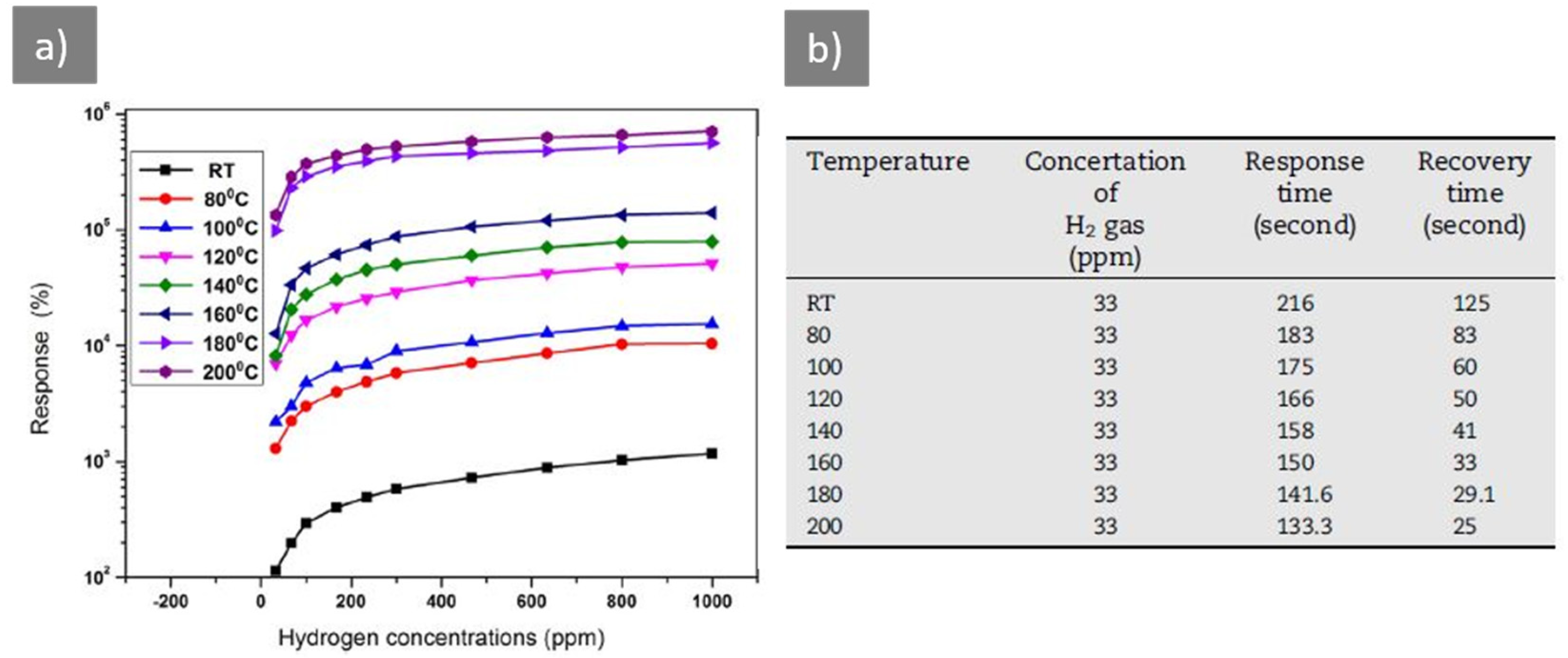




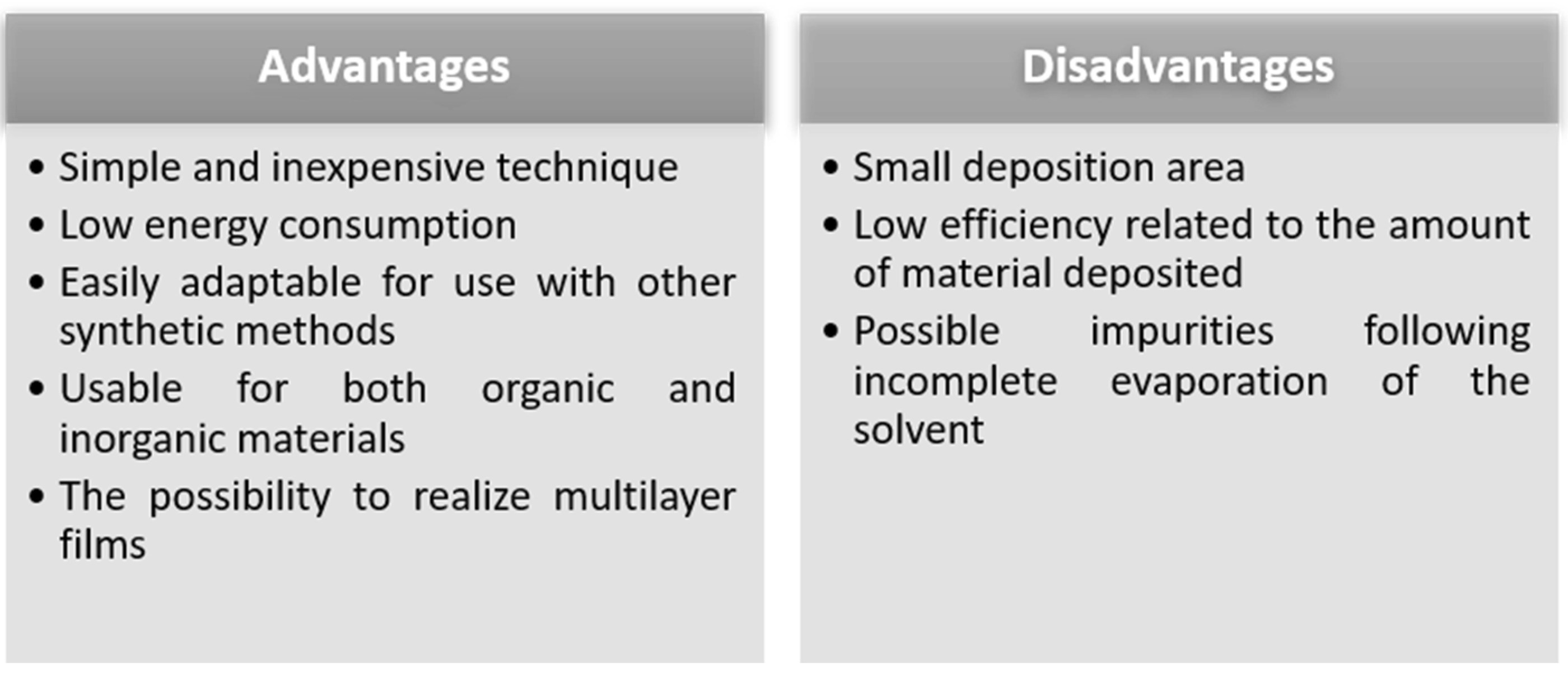
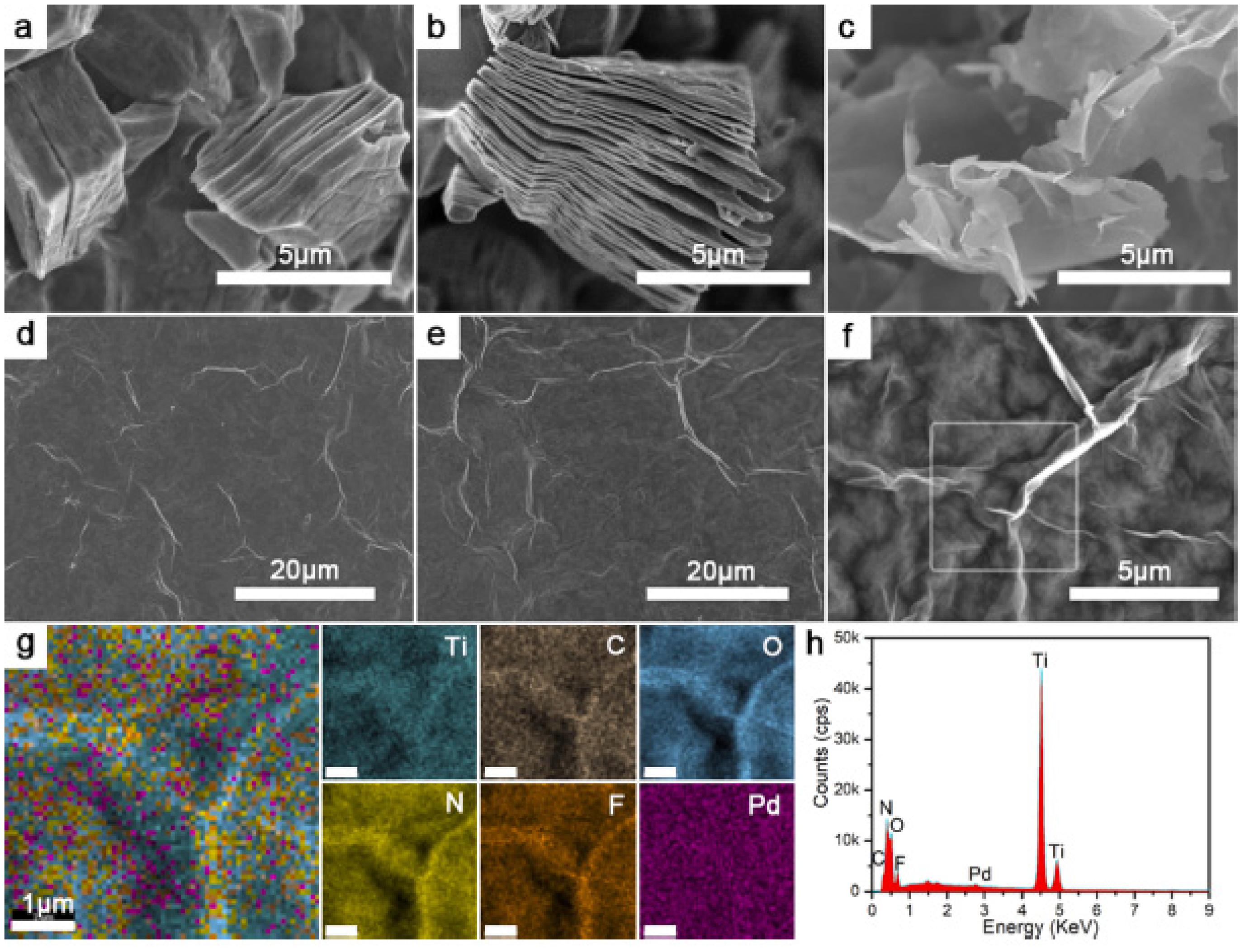
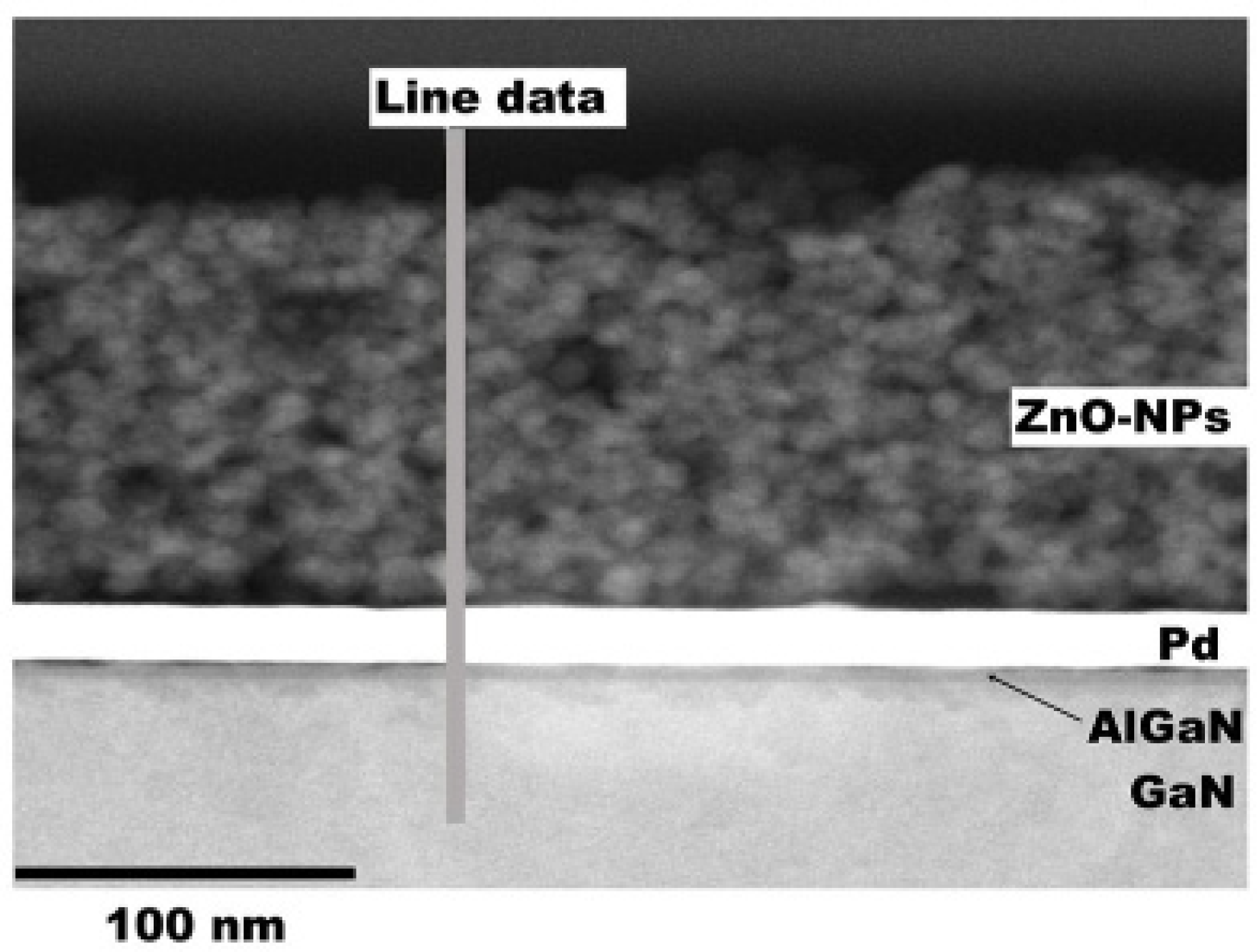
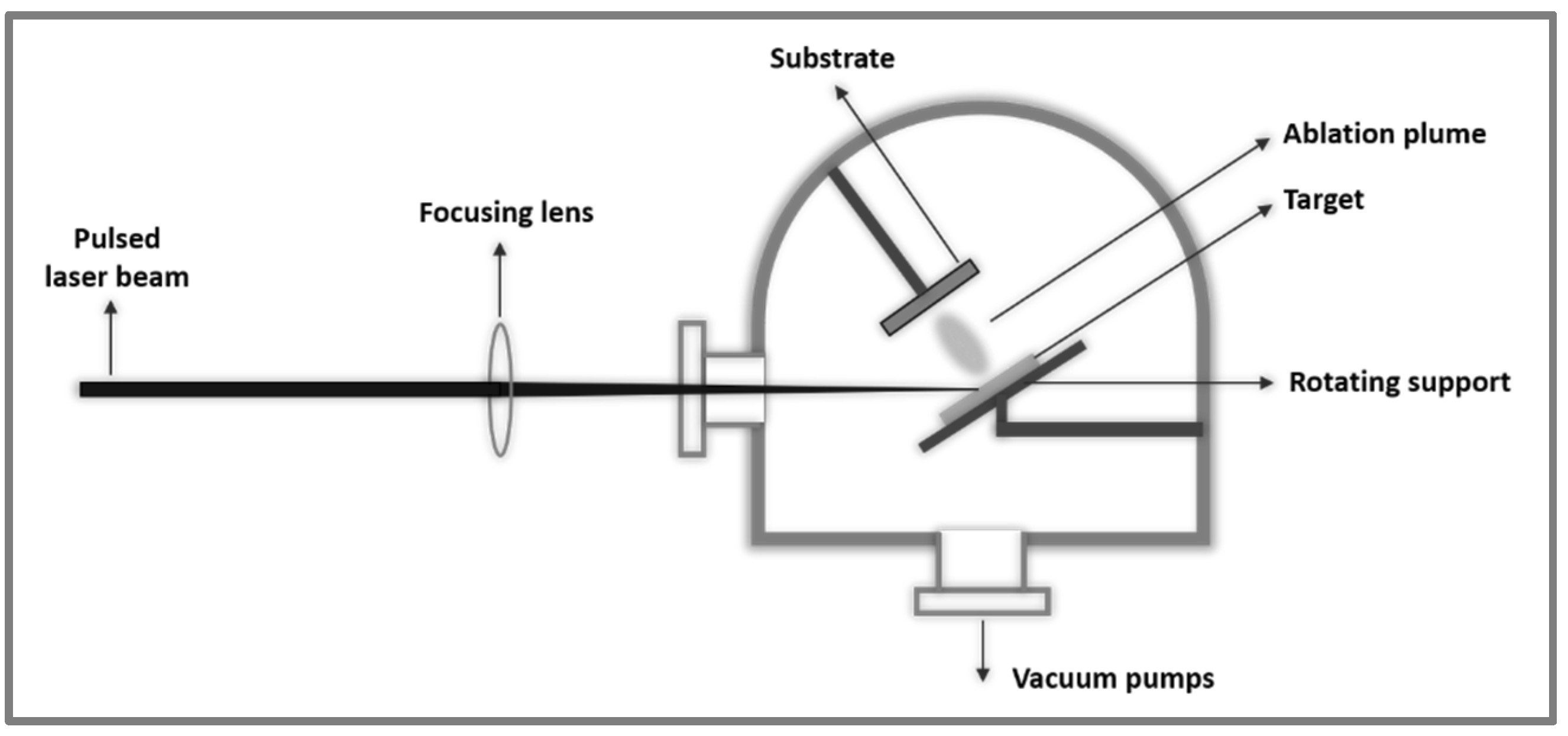


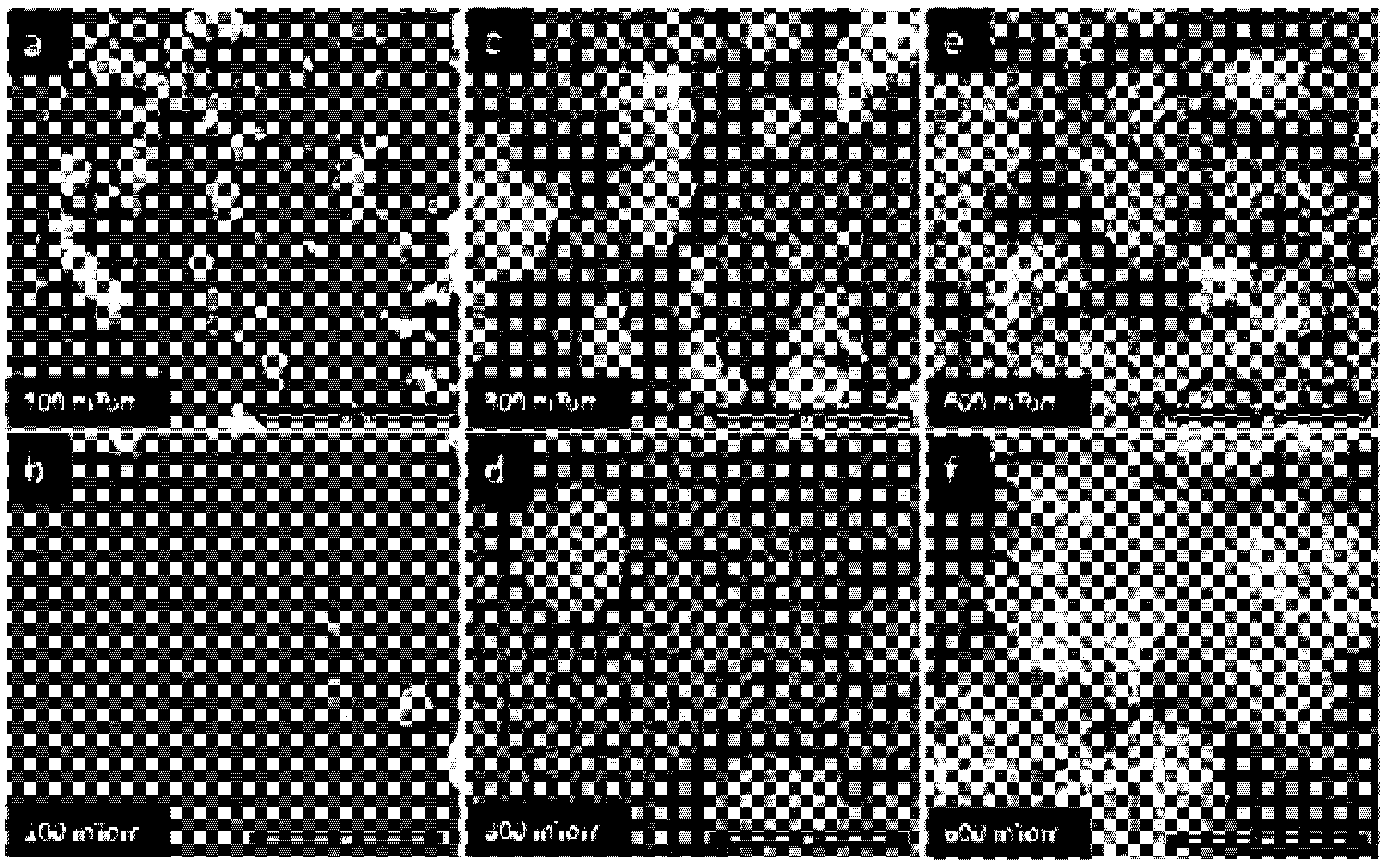
| Sensitive Material | Synthesis Method of the Sensitive Material | Morphology | Hydrogen Concentration | Response | Temperature | Reference |
|---|---|---|---|---|---|---|
| Pd | Evaporation | Nanoporous | 2% | ~0.037 (normalized resistance) | RT | [1] |
| p-TiO2 and Pd/p-TiO2 | Sol-gel and dip coating | Nanoparticles with nanocracks | 1% (in N2) | 60.56 (%) | 150 °C | [48] |
| Pd/SnO2/SiO2 | RF Magnetron sputtering | Thin films | 0.05% | 611–1317% | RT | [50] |
| WO3/PdO | Precipitation | Nanorods | 30,000 ppm | 3.14 × 106 (Ra/Rg) | 150 °C | [52] |
| TiO2/Pd | DC Magnetron sputtering | Nanotubes | 10 ppm | 1.25 (ΔR/RH2) | 180 °C | [51] |
| ZnO | Thermal oxidation | Nanosheets | 10 ppm | 1.089 (Rair/RH2) | 175 °C | [55] |
| Pd/SnO2 | In situ self-assembling | Thin film | 100 ppm | 3 (Vg/Va) | 180 °C | [56] |
| 0.6 wt% Pd/ZnO NFs | Electrospinning and electron beam irradiation | Nanofibres | 0.1 ppm | 74.7 (Ra/Rg) | 350 °C | [53] |
| Pd/Mg | Pulsed Laser Deposition | Thin films | 2 bar H2 gas atmospheres | 37% | RT | [54] |
| Pd@ZnO-In2O3 | Hydrothermal | Core-shell nanoparticles | 100 ppm | 42 (Ra/Rg) | 300 °C | [28] |
| Al-Mg co-doped ZnO | Sol-gel in supercritical conditions | Nanoparticles | 2000 ppm | 70 (Ra/Rg) | 250 °C | [2] |
Publisher’s Note: MDPI stays neutral with regard to jurisdictional claims in published maps and institutional affiliations. |
© 2021 by the authors. Licensee MDPI, Basel, Switzerland. This article is an open access article distributed under the terms and conditions of the Creative Commons Attribution (CC BY) license (https://creativecommons.org/licenses/by/4.0/).
Share and Cite
Constantinoiu, I.; Viespe, C. Synthesis Methods of Obtaining Materials for Hydrogen Sensors. Sensors 2021, 21, 5758. https://doi.org/10.3390/s21175758
Constantinoiu I, Viespe C. Synthesis Methods of Obtaining Materials for Hydrogen Sensors. Sensors. 2021; 21(17):5758. https://doi.org/10.3390/s21175758
Chicago/Turabian StyleConstantinoiu, Izabela, and Cristian Viespe. 2021. "Synthesis Methods of Obtaining Materials for Hydrogen Sensors" Sensors 21, no. 17: 5758. https://doi.org/10.3390/s21175758
APA StyleConstantinoiu, I., & Viespe, C. (2021). Synthesis Methods of Obtaining Materials for Hydrogen Sensors. Sensors, 21(17), 5758. https://doi.org/10.3390/s21175758







